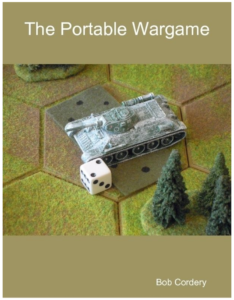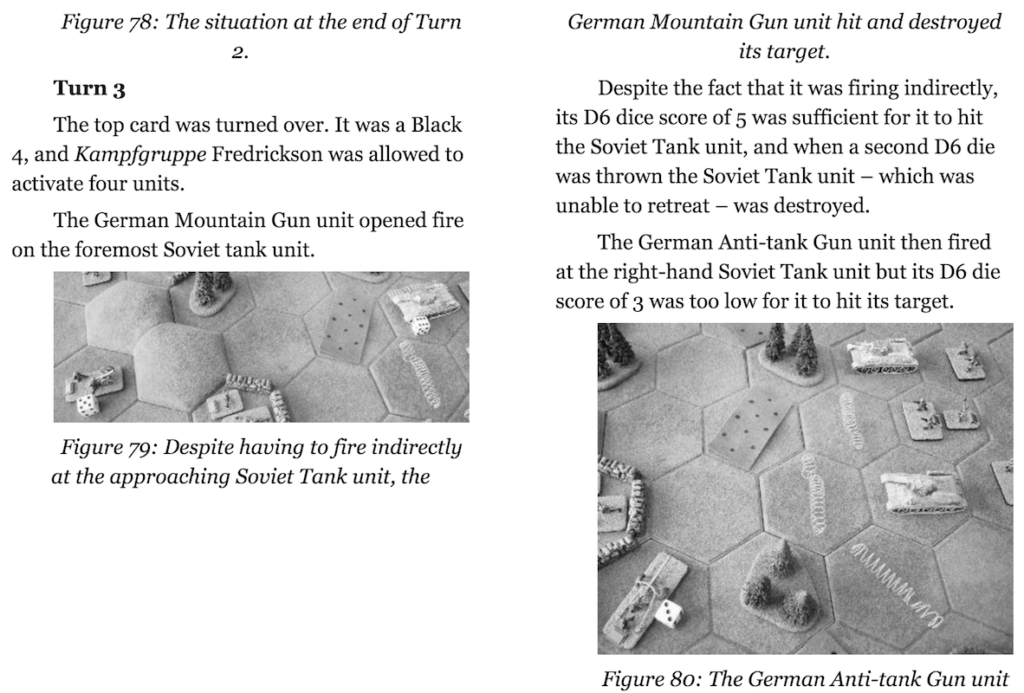Bob Cordery, 2017
102 pages
This book presents Bob’s rules for fast-play war-game rules; where battles are played out on a gridded table-top. The rules are designed for a small footprint game; not everyone has the space for a large table, free time to paint large numbers of miniature figures or room enough to store it all…
In the first 11 pages we learn a bit about how the game rules came about as well as some history of grid based wargames.
The next 16 page cover; some basic rules and description of grids, lines-of-sight, arcs-of-fire and so forth. All well presented, perhaps a bit too much detail for the experienced gamer, but very helpful (well illustrated) for anyone new to wargames.
Next on to units and how to represent them on the table-top. This section is five (5) pages long with some good photographs. Not too detailed for the old guard and instructive for the new gamer. The one thing I do find lacking is a selection of recommendations for beginning army composition. I realize that there are any possibilities here, but new gamers may have a hard time deciding what forces they may need. Perhaps an added appendix, in a future editor, could help address this.
Before moving into actual game rules, there is a short (four page) section covering Bob’s design notes. This is a nice addition; something of the design philosophy is always nice to have.
From there we proceed with rules for the late nineteenth century, including colonial, battles. This section is well organized and should serve a beginning warmer well. Following the rules is an illustrated (includes numerous photographs) battle report.
Next up are rules for an early to mid twentieth century wargame. Again, well organized and followed by another (equally illustrative) battle report.
A bit about game play; This is an IGOUGO sequence game. Units are assigned strength points and each side has an Exhaustion Point (1/3 total strength rounded up) when reached will cause the army to cease offensive action. Turns start with an Artillery Fire Phase, followed by alternating unit activations (each unit may: move, move & fire or initiate close combat). Artillery fire is simultaneous; roll a die, apply modifies to obtain results. Movement, as iis all distances measured by grid spaces. For Fire Combat, attacker rolls a die and applies modifiers to obtain results. In Close Combat both players roll a die, applying modifiers to determine the result. Special rules for various types of terrain and transport are provided.
The battle reports are good and they are useful; a bit too long (nearly 20 pages fro 19th century and about 15 pages for 20th century) for my taste, but very informative for the new wargamer. I would think the space could be better used for example army lists or the like; much like the Army Lists section in the book: When Empires Clash.
Thus ends the main portion of the book. The appendix presents Some thoughts on war-game design and this is followed by a short bibliography and footnotes section.
I have enjoyed reading this book, I purchased the paperback and ebook (Kindle) versions. The book is also available in a hardback edition. The book is well illustrated, drawings and photos. I found the photos appear best when viewing the Kindle edition, on a color screen (Kindle Fire or Desktop computer readers). The printed versions is best for players, since the charts & tables are more accessible (as to be expected, give the limits of ebook viewers).
I recommend this book to anyone intruded in small wargames or in grid based miniature wargames. I would say that is is a ‘must have’ for the war-game student.
You can purchase a copy from either:
Lulu: http://www.lulu.com/shop/bob-cordery/the-portable-wargame/paperback/product-23048800.html
or
Amazon: https://www.amazon.com/dp/1326904582/ref=cm_sw_r_fa_dp_t2_GI1KybVMDX5GG




Good review. Thanks.